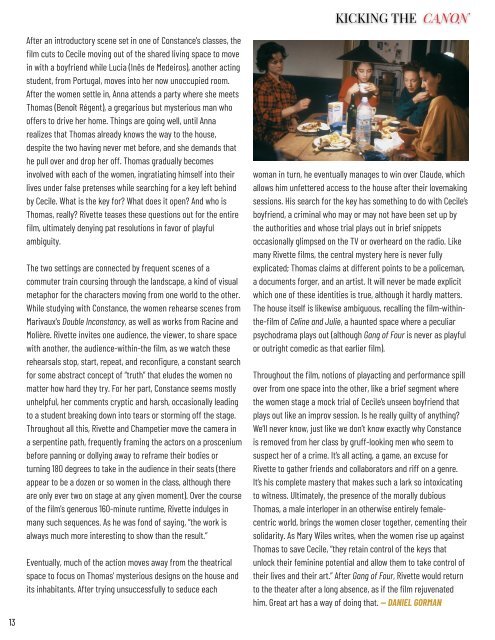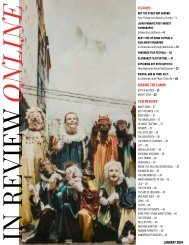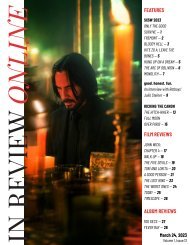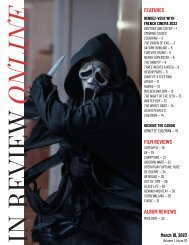You also want an ePaper? Increase the reach of your titles
YUMPU automatically turns print PDFs into web optimized ePapers that Google loves.
KICKING THE CANON<br />
After an introductory scene set in one of Constance's classes, the<br />
film cuts to Cecile moving out of the shared living space to move<br />
in with a boyfriend while Lucia (Inês de Medeiros), another acting<br />
student, from Portugal, moves into her now unoccupied room.<br />
After the women settle in, Anna attends a party where she meets<br />
Thomas (Benoît Régent), a gregarious but mysterious man who<br />
offers to drive her home. Things are going well, until Anna<br />
realizes that Thomas already knows the way to the house,<br />
despite the two having never met before, and she demands that<br />
he pull over and drop her off. Thomas gradually becomes<br />
involved with each of the women, ingratiating himself into their<br />
lives under false pretenses while searching for a key left behind<br />
by Cecile. What is the key for? What does it open? And who is<br />
Thomas, really? Rivette teases these questions out for the entire<br />
film, ultimately denying pat resolutions in favor of playful<br />
ambiguity.<br />
The two settings are connected by frequent scenes of a<br />
commuter train coursing through the landscape, a kind of visual<br />
metaphor for the characters moving from one world to the other.<br />
While studying with Constance, the women rehearse scenes from<br />
Marivaux's Double Inconstancy, as well as works from Racine and<br />
Molière. Rivette invites one audience, the viewer, to share space<br />
with another, the audience-within-the film, as we watch these<br />
rehearsals stop, start, repeat, and reconfigure, a constant search<br />
for some abstract concept of “truth” that eludes the women no<br />
matter how hard they try. For her part, Constance seems mostly<br />
unhelpful, her comments cryptic and harsh, occasionally leading<br />
to a student breaking down into tears or storming off the stage.<br />
Throughout all this, Rivette and Champetier move the camera in<br />
a serpentine path, frequently framing the actors on a proscenium<br />
before panning or dollying away to reframe their bodies or<br />
turning 180 degrees to take in the audience in their seats (there<br />
appear to be a dozen or so women in the class, although there<br />
are only ever two on stage at any given moment). Over the course<br />
of the film's generous 160-minute runtime, Rivette indulges in<br />
many such sequences. As he was fond of saying, “the work is<br />
always much more interesting to show than the result.”<br />
Eventually, much of the action moves away from the theatrical<br />
space to focus on Thomas' mysterious designs on the house and<br />
its inhabitants. After trying unsuccessfully to seduce each<br />
woman in turn, he eventually manages to win over Claude, which<br />
allows him unfettered access to the house after their lovemaking<br />
sessions. His search for the key has something to do with Cecile’s<br />
boyfriend, a criminal who may or may not have been set up by<br />
the authorities and whose trial plays out in brief snippets<br />
occasionally glimpsed on the TV or overheard on the radio. Like<br />
many Rivette films, the central mystery here is never fully<br />
explicated; Thomas claims at different points to be a policeman,<br />
a documents forger, and an artist. It will never be made explicit<br />
which one of these identities is true, although it hardly matters.<br />
The house itself is likewise ambiguous, recalling the film-withinthe-film<br />
of Celine and Julie, a haunted space where a peculiar<br />
psychodrama plays out (although Gang of Four is never as playful<br />
or outright comedic as that earlier film).<br />
Throughout the film, notions of playacting and performance spill<br />
over from one space into the other, like a brief segment where<br />
the women stage a mock trial of Cecile’s unseen boyfriend that<br />
plays out like an improv session. Is he really guilty of anything?<br />
We’ll never know, just like we don’t know exactly why Constance<br />
is removed from her class by gruff-looking men who seem to<br />
suspect her of a crime. It’s all acting, a game, an excuse for<br />
Rivette to gather friends and collaborators and riff on a genre.<br />
It’s his complete mastery that makes such a lark so intoxicating<br />
to witness. Ultimately, the presence of the morally dubious<br />
Thomas, a male interloper in an otherwise entirely femalecentric<br />
world, brings the women closer together, cementing their<br />
solidarity. As Mary Wiles writes, when the women rise up against<br />
Thomas to save Cecile, “they retain control of the keys that<br />
unlock their feminine potential and allow them to take control of<br />
their lives and their art.” After Gang of Four, Rivette would return<br />
to the theater after a long absence, as if the film rejuvenated<br />
him. Great art has a way of doing that. <strong>—</strong> DANIEL GORMAN<br />
13<br />
2
















